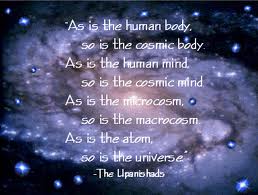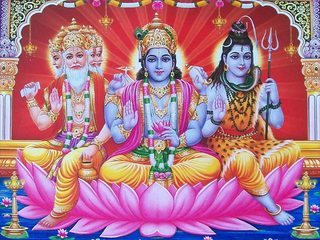The significance of 🕉️🕉️ in sanatan dharma 🚩🚩
Dayanand clarified on his satynash Prakash that aum is the highest,supreme name of supreme reality of BrhmAn,everything which is mentioned in Vedas,brhman grantha and Upanishad all are merely subject oriented name of nirakar paramatma.Is it?none of the smriti sruti clarifies if.I am going to prove Arya samaj wrong on this very beginning thing of Hinduism from fac
ts and evidence ....
Hari OM. Be peace to us Mitra. Be peace to us Varuna. Be peace to us Aryaman. Be peace to us Indra and Brihaspati. May far-striding Vishnu be peace to us. Adoration to the Eternal. Adoration to thee, O Vayu. Thou, thou art the visible Eternal and as the visible Eternal I will declare thee. I will declare Righteousness! I will declare Truth! May that protect me! May that protect the speaker! Yea, may it protect me! May it protect the speaker. OM! Peace! Peace! Peace!( From the taiiteriya Upanishad mantra no 1) peace to us - śam naḥ | मित्रः - mitraḥ - Mitra | शम् वरुणः - śam varuṇaḥ - be peace to us Varuna | अर्यमा - aryamā - Aryaman | नः - naḥ - to us | श भवतु - śa bhavatu - be peace | शम् नः - śam naḥ - be peace to us | इन्द्रः - indraḥ - Indra | बृहस्पति च - bṛhaspati ca - be peace to us Brihaspati | उरुक्रमः विष्णुः - urukramaḥ viṣṇuḥ - May far striding Vishnu | नः शम् - naḥ śam - be peace to us | ब्रह्मणे नमः - brahmaṇe namaḥ - Adoration to the Eternal | वायो - vāyo - O Vayu ! | ते नमः - te namaḥ - Adoration to thee | त्वम् एव - tvam eva - Thou, thou art | प्रत्यक्षम् ब्रह्म असि - pratyakṣam brahma asi - the visible Eternal | त्वाम् एव - tvām eva - thee | प्रत्यक्षम् ब्रह्म - pratyakṣam brahma - as the visible Eternal | वदिष्यामि - vadiṣyāmi - I will declare | ऋतम् वदिष्यामि - ṛtam vadiṣyāmi - I will declare Righteousness | सत्यम् वदिष्यामि - satyam vadiṣyāmi - I will declare Truth | तत् माम् अवतु - tat mām avatu - may that protect me | तत् वक्तारम् अवतु - tat vaktāram avatu - May that protect the Speaker | अवतु माम् - avatu mām - may it protect me | अवतु वक्तारम् - avatu vaktāram - may it protect the Speaker | म् शान्तिः शान्तिः शान्तिः - m śāntiḥ śāntiḥ śāntiḥ - OM Peace! Peace! Peace!
This doesn't match !!
om, tridaivat[y]a
(ओĬ, िņदैवत/िņदैवþय = om, tridaivat[y]a)
MEANING
‘‘
[having] three gods—Brahma, Vishnu, and Shiva.’’
EXPLANATION
This is probably the most popular meaning of OM. The single
syllable OM is composed of three sounds—a (as in alone), u (as
in full), and m (as in mind). As per Sanskrit sandhi rules, when
the sounds a and u come together, the resulting sound is o (as in
the German word Ober). Thus, a + u + m results in OM.
The three component sounds of OM represent Vishnu, Shiva,
and Brahma, respectively. In addition to the Yogi Yajnavalkya
Smriti and Purana‑s which offer this explanation, the meanings of
the three component sounds are also attested in secular sources
like lexicons. As per the Ekakshara Kosha, the word a means
Vishnu and the word u means Shiva. The lexicon gives three
meanings of the word ma (Shiva, the moon, and Brahma) from
which Brahma is taken as the meaning of the sound m in OM.
As per Smriti and Tantra texts, OM is also known as tri-daivata
and tri-daivatya. The words daivata and daivatya are derived from
the root √div, which is also the root of the word deva (“god”).
The Sanskrit word deva is believed to be cognate with the Greek
word theos and Latin word deus, with which the English word
divine is related. Although the root √div has ten meanings in
Sanskrit, in this context it means “to shine”. Therefore, the
names tri-daivata and tri-daivatya mean “having three shining
gods (Brahma, Vishnu, and Shiva)”.a + u + m + bindu + nāda → om.
a ▶ Brahma; u ▶ Vishnu; m ▶ Rudra; bindu ▶ Maheshvara; nāda ▶
Sadashiva.
QUOTES
“The sound a is the creator Brahma, u is the protector Vishnu,
and m is the destroyer Hara (Rudra). The bindu is the deity
Maheshvara, proclaimed to be concealment. The nada is said to
be Sadashiva, bestowing grace on everybody. After meditating
above the nada, the most supreme Shiva [is seen].”
—Shiva Purana. Shvetashvatara
Upanishad, Brahman is described as udgita (उƦीत), which has
the same meaning as udgitha (उƦीथ). A cognate word is udgata
(उƦाता) which means a singer of the Sama Veda. In the Gita,
Krishna says that among the Veda‑s, he is the Sama Veda. The
Chandogya Upanishad proclaims udgitha to be the essence (rasa)
of Sama Veda. OM is thus the essence of the foremost Veda—it is
described in the Upanishad as the essence of all essences (p. 148).
In the Durga Saptashati, Indra and the gods praise Shakti as the
resting place of the Veda‑s, the recitation of whose words is made
mellifluous by udgitha (p. 45).
While the name udgitha is rarely mentioned in the Purana‑s
and Itihasa‑s, there is description of OM being sung or chanted√gai + thak → udgītha.
ut + √gai ▶ to sing or chant aloud; thak ▶ suffix indicating object
of the action.
QUOTES
“Then, verily, what is udgitha is pranava (OM). What is
pranava (OM) is udgitha.”
—Chandogya Upanishad
“OM is known as udgitha.”
—Yogi Yajnavalkya Smriti
“Vishnu was singing aloud OM with [one] mouth.”
—Bhishma’s description, Mahabharata
“Shiva was singing aloud the great OM with his mouth.”
—Kurma Purana Omkara ... pranava ... two [synonyms] of vedarambha.”
—Commentary on Amara Kosha
“In the beginning, there was only one Veda—OM.”
—Bhagavata Purana
Now I am gonna quoting from mandukya Upanishad mantra 7,8,9 :-
Now this the Self, as to the imperishable Word, is OM; and as to the letters, His parts are the letters and the letters are His parts, namely, A U M. The Waker, Vaiswanor, the Universal Male, He is A, the first letter, because of Initiality and Pervasiveness; he that knoweth Him for such pervadeth and attaineth all his desires; he becometh the source and first.
जागरितस्थानः - jāgaritasthānaḥ - the Waker |वैश्वानरः - vaiśvānaraḥ - Vaiswanara, the Universal Male | अकारः - akāraḥ - he is A | प्रथमा मात्रा - prathamā mātrā - the first letter | आप्तेः - āpteḥ - because of Pervasiveness | आदिमत्वात् वा- ādimatvāt vā - and Initiality | यः एवम् वेद - yaḥ evam veda - that knoweth Him for such | सः ह वै- saḥ ha vai - he | सर्वान् कामान् - sarvān kāmān - all his desires | आप्नोति - āpnoti - pervadeth and attaineth | आदि च भवति - ādi ca bhavati - he becometh the source and first
The Sleeper, Prajna, the Lord of Wisdom, He is M, the third letter, because of Measure and Finality; he that knoweth Him for such measureth with himself the Universe and becometh the departure into the Eternal.
सुषुप्तस्थानः - suṣuptasthānaḥ - the Sleeper | प्राज्ञः- prājñaḥ - Prajna, the Lord of Wisdom | तृतीया मात्रा - tṛtīyā mātrā - the third letter | मकारः - makāraḥ - he is M | मितेः - miteḥ - because of Measure | अपीतेः वा - apīteḥ vā - and Finality | यः एवम् ह वेद - yaḥ evam ha veda - he that knoweth Him for such | इदम् वै - idam vai - the Universe |मिनोति - minoti - measureth with himself |अपीतिः च भवति - apītiḥ ca bhavati - and becometh the departure into the Eternal. Now I am going to elaborate this :- With its threefold nature, special shape and unique sound, Om lends itself to a variety of detailed symbolic interpretations. The symbol of AUM consists of three curves (curves 1, 2, and 3), one semicircle (curve 4), and a dot.
The large lower curve 1 symbolizes the waking state (jagrat), in this state the consciousness is turned outwards through the gates of the senses. The larger size signifies that this is the most common ('majority') state of the human consciousness.
The upper curve 2 denotes the state of deep sleep (sushupti) or the unconscious state. This is a state where the sleeper desires nothing nor beholds any dream.
The middle curve 3 (which lies between deep sleep and the waking state) signifies the dream state (swapna). In this state the consciousness of the individual is turned inwards, and the dreaming self beholds an enthralling view of the world behind the lids of the eyes.
These are the three states of an individual's consciousness, and since Indian mystic thought believes the entire manifested reality to spring from this consciousness, these three curves therefore represent the entire physical phenomenon.
The dot signifies the fourth state of consciousness, known in Sanskrit as turiya. In this state the consciousness looks neither outwards nor inwards, nor the two together. It signifies the coming to rest of all differentiated, relative existence This utterly quiet, peaceful and blissful state is the ultimate aim of all spiritual activity. This Absolute (non-relative) state illuminates the other three states.
Finally, the semi circle symbolizes maya and separates the dot from the other three curves. Thus it is the illusion of maya that prevents us from the realization of this highest state of bliss.
The semi circle is open at the top, and when ideally drawn does not touch the dot. This means that this highest state is not affected by maya. Maya only affects the manifested phenomenon. This effect is that of preventing the seeker from reaching his ultimate goal, the realization of the One, all-pervading, unmanifest, Absolute principle. In this manner, the form of OM represents both the unmanifest and the manifest, the noumenon and the phenomenon.its very opening verse, the Mandukya Upanishad describes the significance of Aum in which it declares Omkara as everything (idam sarvam), the past, the present and the future and also whatever there is beyond the threefold time. As the ultimate Brāhman it has four quarters, the waking state (jagrata) presided by Vaisvanara (universal man), the dream state (svapna) presided by taijasa (illumined being), deep sleep state (susupta) presided by prajna (intelligent being) and the transcendental state (turiya) presided by the individual Self (atman) which in reality is but Brāhman Himself.
If 🕉️be the highest nama of the BrhmAn,then why Buddhist monks used to chant Om mani padmaha~while mediation despite being agnostic,in samaveda Chandogya Upanishad it's clearly shows aum is pranava,so it shows dayanand and his dumb followers are trying to save bogus dayanand from embarrassment ,I challenge Vivek Arya,rahul Arya ,mumukhsh Arya if they have guts prove me wrong otherwise shut the fucking mouth ..
Dayanand exposed
Arya samaj exposed!!




Comments
Post a Comment